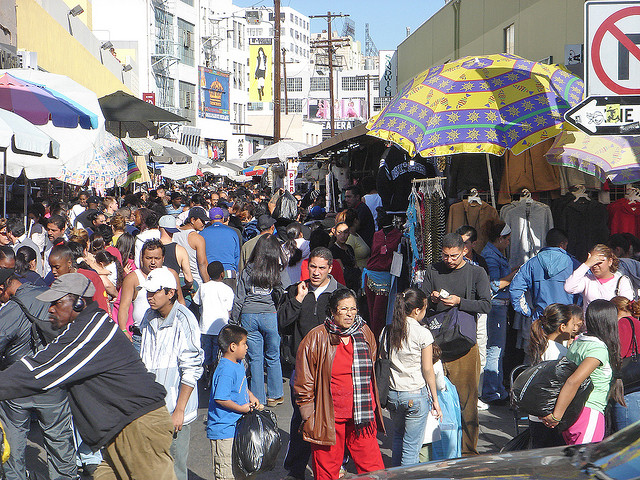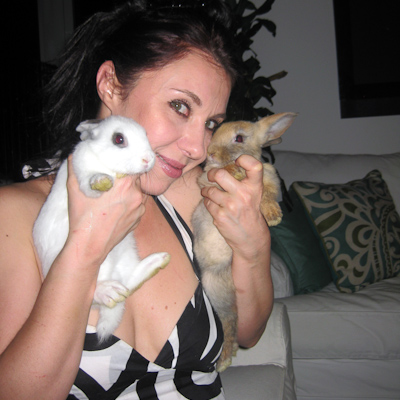Illegal Animal Sales In Downtown L.A.: The Continuous Cycle
In the heart of L.A.’s Fashion District, officers of the Los Angeles Police Department comb through the streets, running after these vendors that are selling the animals out of small cages with no food or water. After wanting to give the suspects a citation, the LAPD officers realize that the suspects aren’t carrying a valid, state-issued ID, which results in an arrest. Despite these arrests, the illegal sale of animals has not stopped; hundreds of animals continue to die from being weaned too early from their mothers.
According to Shafer, in just two years he had arrested more than 15 suspects on suspicion of animal cruelty and not having a valid ID. Animal sales are illegal because any animal sale has to be regulated by animal control. For example, all pet stores are thoroughly inspected for animal cruelty by the Department of Animal Care and Control.
While illegal, sidewalk sales are just a misdemeanor. According to Shafer, “California State Law states that animals aren’t considered humans but are considered property; and that’s where all the problems lie.”
L.A.’s Fashion District is known for its liveliness and low prices on clothes, shoes, and tailored suits. Shoppers don’t intend to stumble across beat-up vans with covered-up windows, in which bunnies are kept in small confinement and scorching heat. These street vendors sell their animals out of small cages with barely any food and water for the cost of a mere $20.
Cheerful kids smile as the vendors hand over newly purchased bunnies. A few days later, however, those smiles break, as the children discover their new bunnies dead. The animals sold on the streets of the Fashion District are in such poor condition, that they often die from various diseases, hypothermia, dehydration, or early weaning from their mothers.
Lejla Hadzimuratovic, the founder of the Bunny World Foundation (an organization that has rescued over 3,000 bunnies), has been rescuing these bunnies from the streets for years now.
“Most of the baby bunnies are infected with coccidia, which is a bacteria that causes diarrhea, and they die,” she says. “Most of the people that buy the bunnies don’t know, and overnight the bunny can just get diarrhea and die. Coccidia is deadly, and we have to fight very hard to get it out of their system. Their immune system is very low because they didn’t get milk from their mothers.”
Furthermore, she says that they are infected with various parasites and illnesses such as pneumonia from being exposed to the cold just seven days after they are born. If Hadzimuratovic rescues a bunny with pneumonia, she needs to nebulize them with antibiotics for days at a time.
“There are bunnies with missing ears," Hadzimuratovic says. "It’s awful, they come in all kinds of conditions, and of course, we struggle to keep them alive."
Weaned from their mothers within days of birth, the baby bunnies are sold as “dwarf bunnies.” At that age, bunnies should only be feeding off their mother's milk, but instead they are fed lettuce and carrots—foods that only fully-grown bunnies should eat. Because of the wrong nourishment, the bunnies get sick in the way Hadzimuratovic described.
However, the bunnies are not the only animals that are in bad conditions. Shafer says that “the turtles have a slight coating of E. coli on their shells, so imagine you get this for a little kid and they are playing with it. Next thing you know, they have E. coli too.”
“The vendors go to the Fashion District with maybe 30 to 40 rabbits squished together in one cage. On a hot summer day, with a hot car and no ventilation, I’m surprised they don’t just die right there,” Shafer says.

Shafer and his team have been arresting the suspects, but ultimately, they often are back out doing the same thing as soon as they are released from jail.
Shafer says that they have had investigators trying to find out where these bunnies are coming from—whether from a breeding farm within one of the vendor’s houses or a pet store supplying the baby bunnies.
Shafer notes that it's often members of the same family selling these animals. Two names that the LAPD knows all too well are Juan Mena, 28, and Norma Pluma, 34, who went on trial for animal sales, child battery, and child endangerment, which concluded last week. According to Shafer, these suspects are currently living in the Rampart Division but are originally from Mexico.
[Watch NBC's coverage here.]
Following Shafer through the streets of the Fashion District as he took me on a tour, it became evident that all the vendors are a very close-knit family. Walking through Santee Alley, we could hear whistles. Within five minutes of walking through the streets, we became aware that we were being followed and watched from various balconies and street corners. At one point, I was told to “look out for a man in a red shirt,” apparently a man who had been tailing us since we had arrived.
"They whistle to alert each other that a cop is near,” Shafer says. “They also have walkie-talkies and they tell each other to hide. They know I’m here before I’ve walked 20 feet.”
Once the vendors spot Shafer, they run to hide in various parking lots and stairways, putting hooks on doors to stop the LAPD officer from following them.
Hadzimuratovic said that not only do these vendors act cruelly on behalf of the animals, but they also have no problem lashing out at people on the streets. For example, Hadzimuratovic said she was attacked by the vendors when she was trying to save the bunnies:
“All of a sudden I was surrounded by 30 gang members. They managed to open my car and started hitting me through the doors, pulling my hair, throwing punches. They also had box cutters so they cut us on our heads, our arms…”
Hadzimuratovic filed a police report, but she said nothing ever happened: "I sent in videos of the attack, photos, evidence, and apparently, it all got lost in the shuffle. No one ever called me back."
She also recalls the time Norma Pluma, one of the suspects, attacked a family. According to a release from the Office of the City Attorney, Pluma and her 11-year old daughter were selling animals on Santee Alley when a concerned family called LAPD. When they arrived, Pluma's daughter threw trashbags over the animals and tried to run, after which she was apprehended and detained. Two bunnies were given to the family that had initially called the police, and the police left. However, the family was then surrounded by a group of people including Pluma, who demanded her bunnies back. Then, she attacked the father and son, prompting another call to LAPD. This is why Pluma and Mena went on trial at the end of November: for child battery, which then opened the doors for the charges on animal cruelty.
“Mena and Pluma attacked the kids,” says Hadzimuratovic. “The dad punched Norma in the face as the kids were laying hurt on the ground.”
The family was too nervous to pursue the matter, so they turned to Hadzimuratovic for help. She prompted NBC to take up the story.
Shafer says that he has arrested Mena for animal cruelty and lack of formal ID four or five times in a span of two years. Hadzimuratovic has been waiting for Mena’s arrest, and the child battery charge finally took Mena and Pluma to court.
According to Frank Mateljan of the Los Angeles City Attorney's Office, the sentencing occurred on December 10th, 2013, and Mena and Pluma were found guilty on charges of illegal animal sales under 53.42 (a) L.A. Municipal Code. Mateljan says that Mena was charged on one count of the illegal sales of bunnies, and he has to serve 180 days in the country jail, with a bail amount of $40,000. He was also convicted of a probation violation, as he always ignored "stay away orders" from the judge. Probation was denied. Norma Pluma was found guilty for battery, animal cruelty, illegal animal sales (bunnies), and illegal animal sales (turtles), as well as onec ount of battery towards an adult. She is on probation for 36 months, and has to complete 30 days of community labor. She was also convicted to 16 days days in jail, which she had served prior to the trial and has now received credit for. Both her and Mena have to stay away from Santee Alley.
[Follow the trial here.]
Before the trail, Shafer had said: “It’s almost as if Mena has a certain disregard for the law, and for just being a decent human being.”
According to the press release of the Bunny World Foundation, the closing statements of both defense attorneys were “ridiculous,” stating “the jury tried to play a race card by saying that Norma Pluma was a ‘poor little Latina woman’ trying to make a living.” Other statement they made included the declaration that it was the LAPD’s fault for giving the bunnies to the family, initially “causing Pluma and Mena to fight for their property” and citing the battery charge as self-defense.

Usually, after the animal vendors are arrested, they are bailed out almost immediately by one of their family members for $100— the equivalent of 5 bunny sales. Then, “they are out here doing the same exact crap again,” says Shafer. Why? Because of the overcrowded jail systems and because it’s not viewed as violent offenses.
In terms of preventing these illegal animal sales, the BID Office has been trying to find ways to educate the public. Kent Smith, Executive Director of the Fashion District BID Office says that “animal vending has been a problem and a concern from the moment we started. We are working with the people who are enforcing it to try to eradicate it.”
Signs have been put up in the fashion district that warn vendors and buyers about the illegality of these sales. Fines for buyers could be up to $1,000. However, Shafer says that there are only two or three signs set up, and they are put so high up and they are so small that people are unable to read what it says on there.
“Signs aren’t going to help the issue,” says Smith. “It’s about helping to educate the public. This isn’t something people should be buying, and we have to address the issue of illegal vending.”
Smith says that the BID office has been providing leaflets to the public. NBC reported that merchants have been handing out fliers to the shoppers, in hopes of stopping these animal sales. McCain believes that “all agencies have to agree that this will not be tolerated,” in order for it to stop.
With the “People vs. Mena and Pluma” trial having come to a close, Hadzimuratovic, Shafer, and the BID office are hoping that there will be a change in the illegal sales of these animals.
Here is some supplemental video footage:
Below is the package about the illegal animal sales:
Reach Contributor Beatrice Verhoeven here. Follow her on Twitter.



